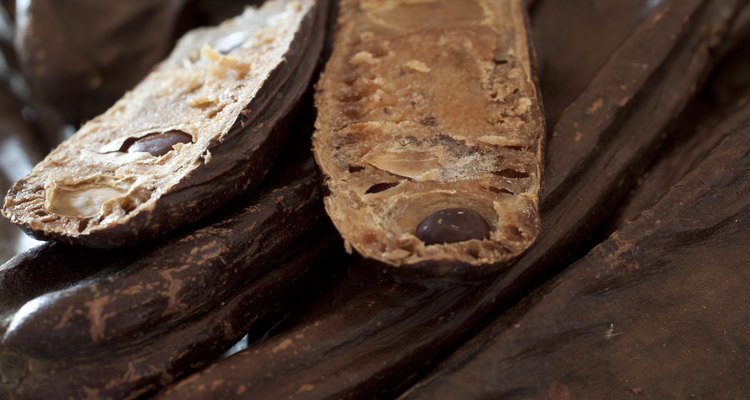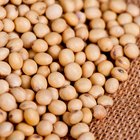
Alessandro de Leo/iStock/Getty Images
Carob is frequently used as a substitute for chocolate because it can be made to taste and look similar to chocolate. Additionally, carob is often touted for its high nutrient content. However, closer examination reveals that both carob and chocolate both are quite nutritious, as long as they do not contain large amounts of added fat or sugar.
Fat
Carob is significantly lower in fat than chocolate. According to the National Nutrient Database for Standard Reference, 1 ounce of unsweetened chocolate contains 15 grams of fat, while 1 ounce of carob flour, which is about 1/4 cup, contains 0 grams of fat. The same amount of cocoa powder, which has had much of the fat-containing cocoa butter removed, provides 4 grams of fat. Carob is a good alternative if you are following a low-fat diet, but carefully examine food labels, because carob-containing products may include added fat from other sources.
Carbohydrate
Another distinctive difference between carob and chocolate is the carbohydrate content. Chocolate contains about 8 grams of carbohydrate per ounce and cocoa powder 16 grams per ounce, but both contain 0 grams of sugar. Carob flour, on the other hand, provides 25 grams of total carbohydrate and 14 grams of sugar per ounce. Just as carob products often contain added fat, many chocolate products contain added sugar, which would offset this difference. Both carob and chocolate are also sources of dietary fiber, containing 11 grams and 5 grams per ounce, respectively.
Vitamins
Both carob and chocolate contain a variety of B vitamins, but carob contains higher concentration of these essential nutrients, including thiamin, riboflavin, niacin, vitamin B6 and folate. Neither is a good source of vitamin B12, which is found mainly in animal products.
Minerals
Both carob and chocolate are also sources of many essential minerals. Carob is particularly high in calcium, containing nearly 100 milligrams per ounce. Calcium is an important mineral for maintaining bone health, according to Medline Plus. Both are rich in iron, magnesium, phosphorus, potassium, zinc, copper, manganese and selenium, but chocolate contains higher concentrations of each of these minerals.
Stimulants
One of the more important differences between carob and chocolate is the level of stimulants they contain. Chocolate contains small concentrations of caffeine and another stimulant called theobromine. According to Medline Plus, certain individuals should limit caffeine intake, including pregnant women and some people with heart conditions. These individuals could use carob as a chocolate substitute, since carob does not contain caffeine or theobromine.
Related Articles

How to Substitute Cocoa Powder for ...

Calories in Dark Chocolate Truffles

Difference Between American and ...

The Difference Between Bittersweet ...

Stimulants in Chocolate That Are not ...

Nutritional Facts of Pure Cocoa

Is Soy Flour Healthy?

Is Soy Milk Casein-Free?

Difference Between Canned Pumpkin & ...
Does Cake Flour Contain Baking Soda & ...

Which Country Produces the Most ...

Baking Substitutions for Unsweetened ...

How to Make Glaze for Donuts With Milk ...

How Does Chocolate Affect the Nervous ...

Cubic Zirconia Vs. White Spinel

Strontium Titanate Vs. Diamond
Calories in Candied Walnuts

Chocolate and Vitamins

FDA Standards of Chocolate Identity

Dairy Substitutes for Quiche
References
Writer Bio
Steven Lalevich is a registered dietitian who began writing in 2010 for various websites. He graduated Phi Beta Kappa, earning a Bachelor of Arts in economics from Indiana University where he also completed the didactic program in dietetics. Lalevich is pursuing a Master of Science in human nutrition at the University of New Haven.
Photo Credits
Alessandro de Leo/iStock/Getty Images